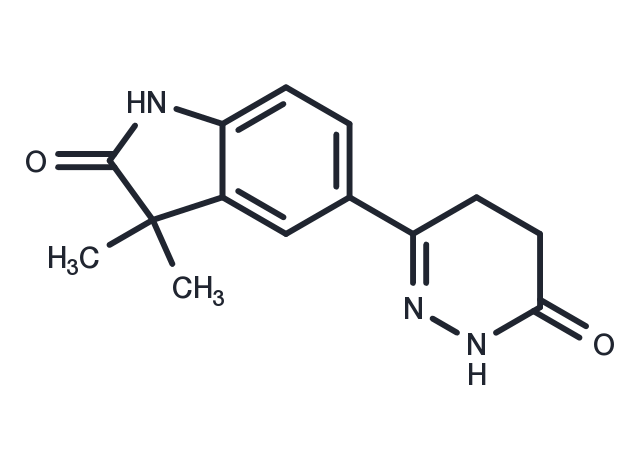Powder: -20°C for 3 years | In solvent: -80°C for 1 year


Indolidan (LY 195115) induces cardiovascular and adrenal hyperplastic lesions in Fischer 344 rats. Indolidan increases the risk of cardiovascular disease.

| Pack Size | Availability | Price/USD | Quantity |
|---|---|---|---|
| 1 mg | In stock | $ 160.00 | |
| 5 mg | In stock | $ 390.00 | |
| 10 mg | In stock | $ 590.00 | |
| 25 mg | In stock | $ 943.00 | |
| 50 mg | In stock | $ 1,280.00 | |
| 100 mg | In stock | $ 1,730.00 | |
| 500 mg | In stock | $ 3,460.00 |


| Description | Indolidan (LY 195115) induces cardiovascular and adrenal hyperplastic lesions in Fischer 344 rats. Indolidan increases the risk of cardiovascular disease. |
| In vivo | Male and female Fischer 344 rats were treated with the positive inotropic agents, isomazole or indolidan, in the diet for 104 weeks. The doses were 0.0, 11.5, 23.5, or 48.0 mg/kg and 0.0, 0.12, 0.40, or 1.3 mg/kg, respectively. Only 17% of the males treated with 48.0 mg/kg isomazole survived the duration of the study. The male component of the indolidan study was terminated at 22 months, with only 18% of the high-dose males surviving. Sixty-five percent of the males treated with 48.0 mg/kg isomazole and 70% of the males treated with 1.3 mg/kg indolidan were found to have severe periarteritis, often with thrombi located mainly in the mesenteric arteries. Fifty-four percent of the male rats treated with 48.0 mg/kg isomazole and 55% of the male rats treated with 1.3 mg/kg indolidan died from cardiovascular disease compared to 1-2% among the control males. Animals in the low- and middle-dose groups of both studies had a lower incidence of cardiovascular disease than did those in the high-dose group. Additional lesions associated with the long-term administration of both drugs were markedly increased incidence of adrenal medullary proliferative lesions (both hyperplasia and pheochromocytomas) and increased incidence of chronic progressive glomerulonephrosis. These lesions, like those in the cardiovascular system, occurred in a dose-dependent manner and were more frequent in males than in females.[5] |
| Synonyms | LY 195115 |
| Molecular Weight | 257.29 |
| Formula | C14H15N3O2 |
| CAS No. | 100643-96-7 |
Powder: -20°C for 3 years | In solvent: -80°C for 1 year
You can also refer to dose conversion for different animals. More
bottom
Please see Inhibitor Handling Instructions for more frequently ask questions. Topics include: how to prepare stock solutions, how to store products, and cautions on cell-based assays & animal experiments, etc.
Indolidan 100643-96-7 LY 195115 LY195115 LY-195115 inhibitor inhibit
